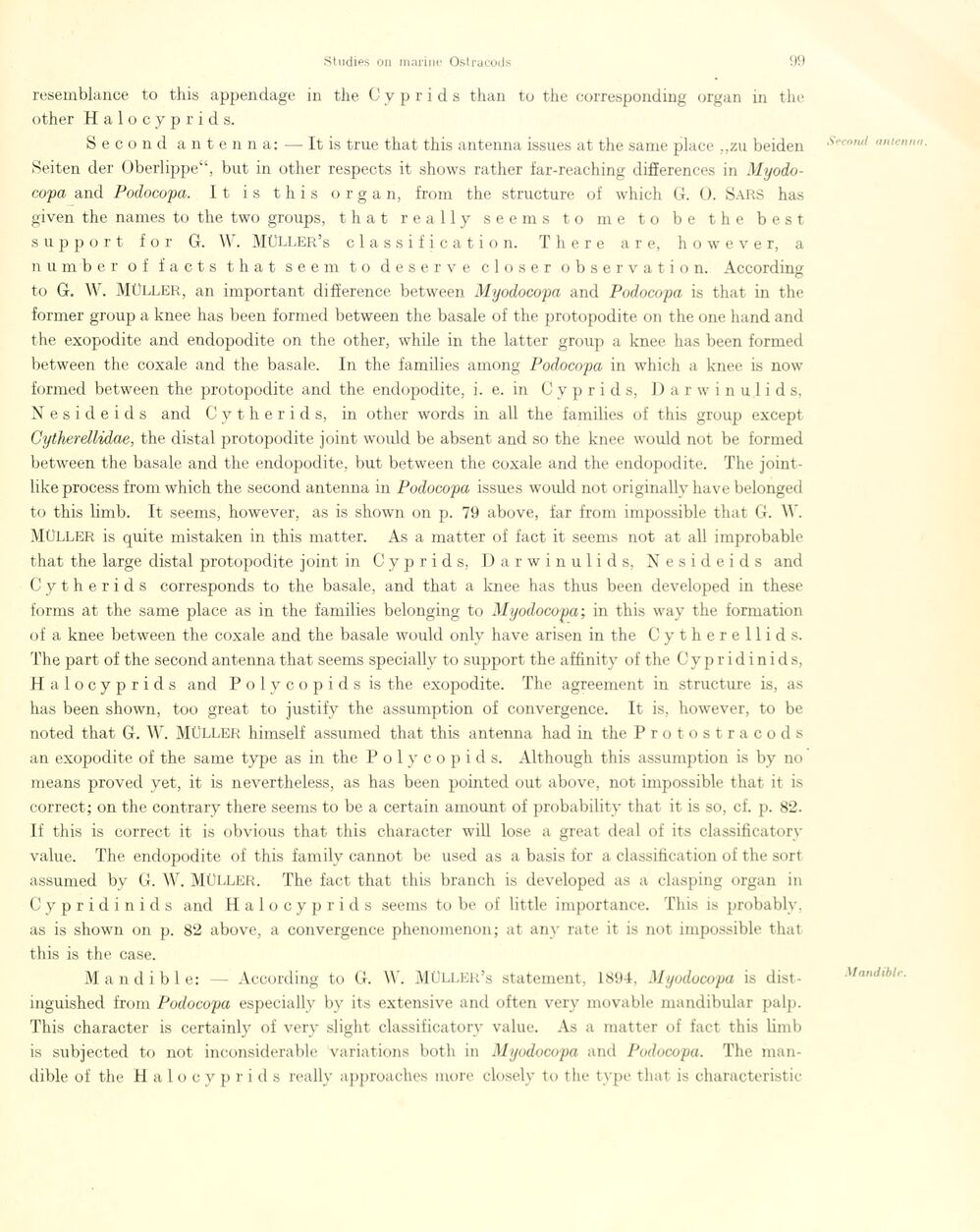
Full resolution (JPEG) - On this page / på denna sida - Sidor ...

<< prev. page << föreg. sida << >> nästa sida >> next page >>
Below is the raw OCR text
from the above scanned image.
Do you see an error? Proofread the page now!
Här nedan syns maskintolkade texten från faksimilbilden ovan.
Ser du något fel? Korrekturläs sidan nu!
This page has never been proofread. / Denna sida har aldrig korrekturlästs.
resemblance to this appendage in the G y p r i d s titan to the corresponding organ in the
other Halocyprids.
Second antenna: — Itis true that this antenna issues at the same place „zu beiden
Seiten der Oberlippe“, but in other respects it shows rather far-reaching differences in
Myodocopa and Podocopa. It is this organ, from the structure of which G. 0. Sars has
given the names to the two groups, that really seems to me to be the best
support for G. W. MüLLER’s classification. There are, h o w e v e r, a
n umber of facts that seem to deser ve doser observation. According
•
to G. W. Müller, an important difference between Myodocopa and Podocopa is that in the
former group a knee has been formed between the basale of the protopodite on the one hånd and
the exopodite and endopodite on the other, while in the latter group a knee has been formed
between the coxale and the basale. In the families among Podocopa in which a knee is now
formed between the protopodite and the endopodite, i. e. in C y p r i d s, Darwinulids,
Nesideids and C y t h e r i d s, in other words in all the families of this group except
Cytherellidae, the distal protopodite joint wo uld be absent and so the knee would not be formed
between the basale and the endopodite, but between the coxale and the endopodite. The
joint-like process from which the second antenna in Podocopa issues would not originally have belonged
to this limb. It seems, however, as is shown on p. 79 above, far from impossible that G. W.
MÜLLER is quite mistaken in this matter. As a matter of faet it seems not at all improbable
that the large distal protopodite joint in Cyprids, Darwinulids, Nesideids and
Cytherids corresponds to the basale, and that a knee has thus been developed in these
forms at the same place as in the families belonging to Myodocopa-, in this way the formation
of a knee between the coxale and the basale would only have arisen in the Cytherellids.
The part of the second antenna that seems specially to support the affinity of the C y p r i d i n i d s,
Halocyprids and Polycopids is the exopodite. The agreement in structure is, as
has been shown, too great to justify the assumption of convergence. It is, however, to be
noted that G. W. MÜLLER himself assumed that this antenna had in the Protostracods
an exopodite of the same type as in the Polycopids. Although this assumption is by no
means proved yet, it is nevertheless, as has been pointed out above, not impossible that it is
correct; on the contrary there seems to be a certain amount of probability that it is so, cf. p. 82.
If this is correct it is obvious that this character will lose a great deal of its classificatorv
value. The endopodite of this family cannot be used as a basis for a classification of the sort
assumed by G. W. MULLER. The faet that this branch is developed as a clasping organ in
Cypridinids and Halocyprids seems to be of little importance. This is probablv.
as is shown on p. 82 above, a convergence phenomenon; at anv rate it is not impossible that
this is the case.
Mandible: — According to G. W. MÜLLER’s statement, 189-4, Myodocopa is
dist-inguished from Podocopa especially by its extensive and often very movable mandibular palp.
This character is certainly of very slight classificatory value. As a matter of faet this limb
is subjeeted to not inconsiderable variations both in Myodocopa and Podocopa. The
mandible of the Halocyprids really approaches more closely to the type that is characteristie
Second antenna.
Mandible.
<< prev. page << föreg. sida << >> nästa sida >> next page >>